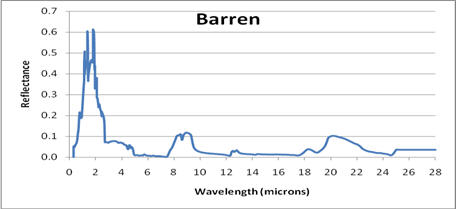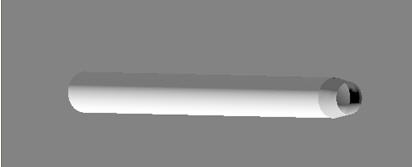EOIR Missile Shape Properties
A missile may change shape as it moves from one stage to the next. For example, the shape of a missile when launched is different than its shape after the first component separates from it. Each STK Missile object represents one stage of a missile. The Basic EOIR Shape properties enable you to define the shape of a particular STK Missile by stacking components. For an example of how to stack components, see Building a missile shape example.
Defining a multistage missile
You need to create one missile object for each missile stage. When defining a stage for a multistage missile, keep in mind the following:
- The shape properties must match the missile stage.
- The Start and Stop times must match the time interval appropriate for the stage.
- You must include the Missile object as a selected target in the EOIR Configuration.
EOIR shape properties
Select or specify the following for each shape composing a stage.
Shape
Choose one of the following for object shape:
- Select a simple geometric: Box, Cone, Coupler (cone frustum), Cylinder, Plate, or Sphere.
- None removes it from the geometric and radiometric calculations while retaining its position and orientation calculations. It is often convenient to assign the parent object to which a sensor is attached as shape None. Since a sensor cannot image its parent object, this speeds up radiometric calculation with little or no effect on the results.
- CustomMesh loads an external model (.obj) file that defines a custom model. The sample_custom_mesh.obj file loads by default. To select a different file, click the ellipsis button. For information on converting a model file to an OBJ file, see Converting 3D Models to OBJ Files for Rendering in EOIR.
- PointSourceSignature loads an external Target Signature file (.tsf) that defines the EOIR properties with a target signature that can vary with time, angle, and wavelength. For information on the file format, click Target Signature file (.tsf).
When an object of one material becomes smaller than a pixel, EOIR will approximate it as follows:
- For simple geometric shapes and custom meshes, EOIR uses an analytical approximation. The calculations for custom meshes occur at five-degree intervals, to keep the computation time from becoming excessive.
- For compound objects consisting of two or more simple geometric shapes, EOIR will approximate each shape as a bounded sphere while estimating the percentage overlap for high-accuracy areas.
Dimensions
You can specify dimensions (e.g., Height, Radius, Width, Depth, Max Dimension) of a simple geometric shape.
Body temperature
For the Body Temperature, click the shortcut menu to choose one of the following options:
| Option | Description |
|---|---|
| Static | STK applies this temperature to the entire shape. This then applies for the entire EOIR scene time period. |
| Time Profile | Loads a time-temperature profile (.tpf) file. The sample_time_profile.tpf file loads by default. To select a different file, click the ellipsis. To create a TPF external file, see TPF data file format. |
| Data Provider | When you select this option, and additional shortcut menu called Temperature Data appears. Click the Temperature Data shortcut menu to choose a temperature parameter from data providers for the object (aircraft, satellite, etc.). If no temperature parameters from data providers are available, the shortcut menu will be gray, so you must then choose a different Body Temperature option. |
Material
This is the material type that appears on the surface of the entire shape. You can select one of the materials in the list or a Custom Material.
The Custom Material option enables you to load an external Spectral Response Function (.srf) file that defines custom materials. This file models operationally relevant materials and accurately characterizes their desired spectral response function. The sample_material_profile.srf file loads by default. To select a different file, click the ellipsis button. To create an SRF external file, see SRF data file format.
Each surface material has optical properties used in the sensor scene calculation. One of these is reflectance. Light bouncing off a surface is selectively reflected by wavelength, i.e., some wavelengths are absorbed instead of reflected. In the visible wavelengths, this is what gives objects color. Each surface material has a table of its Reflectance versus Wavelength.

One particular material, Gray Body, has a user-selectable reflectance that is constant across the spectrum. It does not represent any real material but is useful for setting up test situations.
For more information on material models, see Material Types Modeled in EOIR.
When an object with two or more materials becomes smaller than a pixel, EOIR will approximate it as a bounded sphere of one material. This can adversely affect calculations. AGI recommends using a point source signature file for this situation.
Reflectance
Reflectance can vary from no light reflected (0 %) to all light is reflected (100 %). This parameter is not valid for the Custom Material option.
Building a missile shape example
The following example shows how to stack components to build a missile shape:
- To define the following initial component, highlight Component 1, select Cylinder as the shape and modify the following properties:
- Height: 10 m
- Radius: 0.5 m
- Body Temperature: 310 K
- Material: White Thermal Control
- To stack a coupler on the cylinder shape, click , highlight Component 2, select Coupler as the shape, and modify the following properties:
- Radius1: 0.5 m
- Height: 0.6 m
- Radius2: 0.4 m
- To stack a cone on the coupler shape, click , highlight Component 3, select Cone as the shape, and modify the following properties:
- Height: 1 m
- Radius: 0.4 m

Radius1 is set to match the Radius of the Cylinder shape.
The following image shows how the coupler is stacked on top of the cylinder.

The following image represents the finished missile shape.
